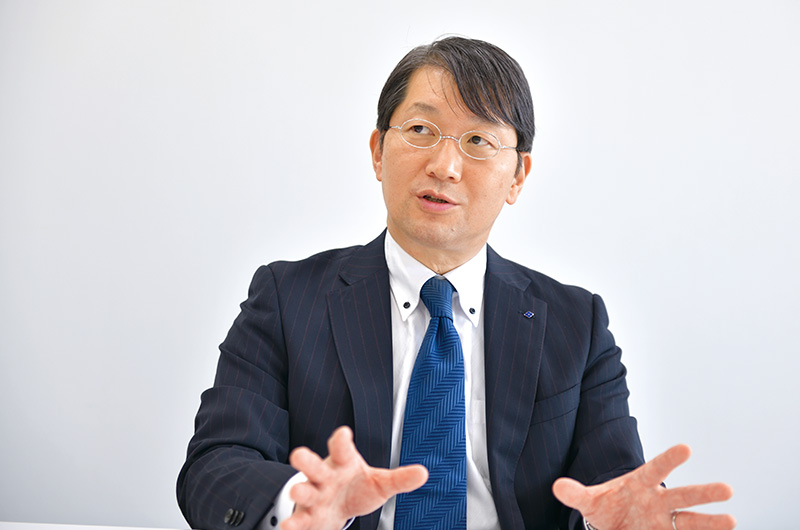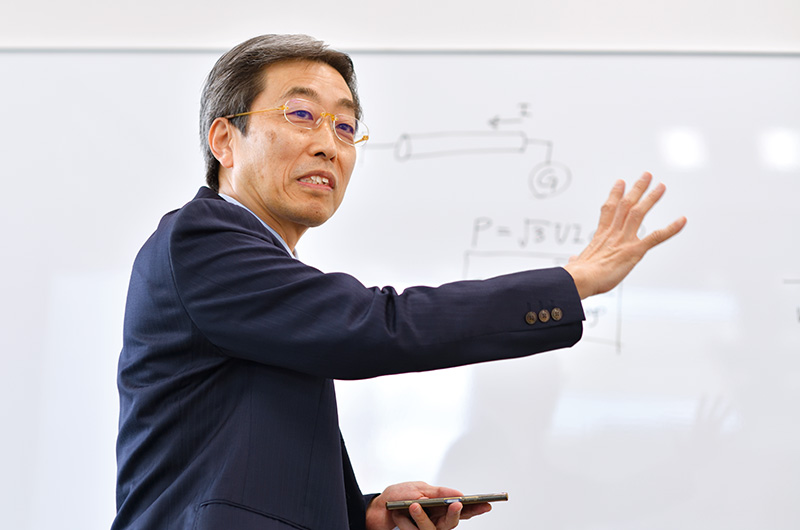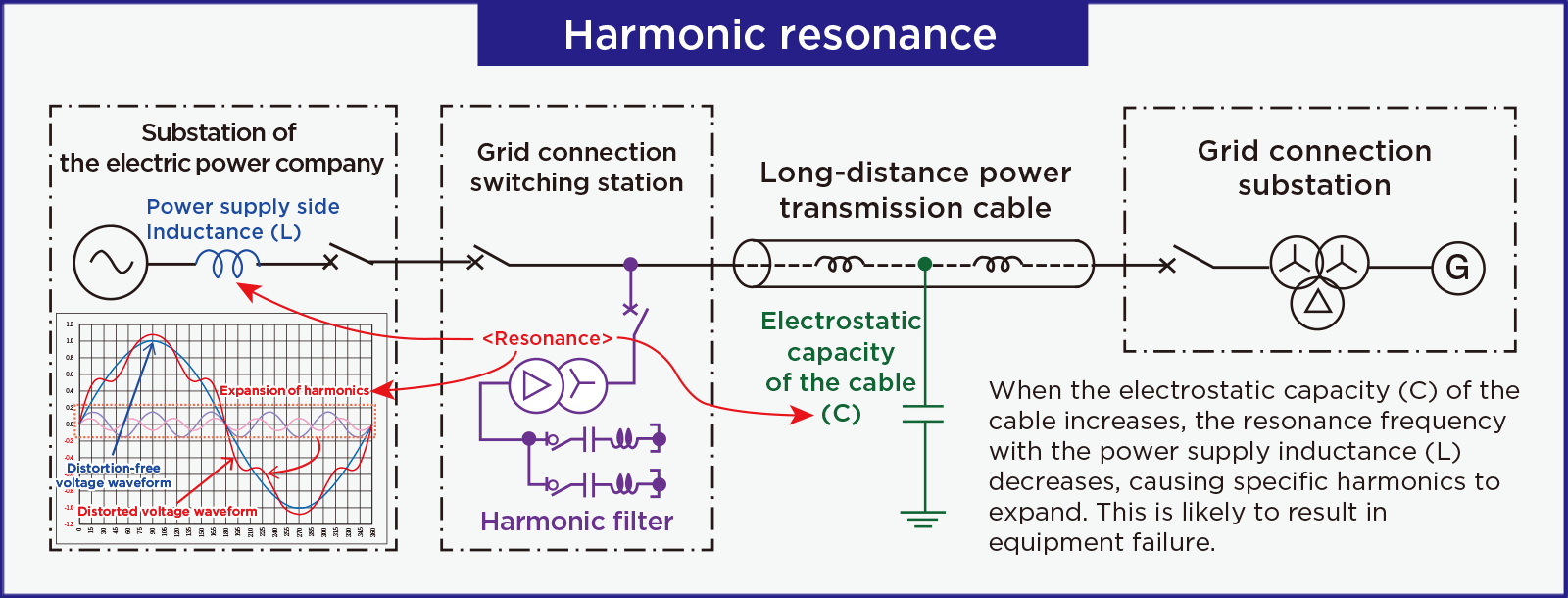Projects id Formidable Social Challenges Challenge to Spread the Use of Renewable Energy— Underpinning the largest wind farm in Japan —
Solving an Unprecedented Problem of Long-Distance Cables — Strength and synergies demonstrated by the Sumitomo Electric Group —
Wind turbine installation work (Photo courtesy of Kajima Corporation)
Offering solutions beyond the scope
of an electric wire manufacturer
The Great East Japan Earthquake brought signs of structural changes in the electricity industry: expansion of renewable energy. Against this backdrop, the Sumitomo Electric Group was expected by renewable energy companies, which were new customers, to offer not only electric cables but also transmission and transformation solutions, including grid design to connect power plants to the grid.
With this in mind, Sumitomo Electric approached GPI, which had been attracting much attention compared to their competitors. The person in charge was Shuji Mayama, who is currently the chief engineer of the Power Cable Project Engineering Div. This was about five years ago, when GPI was conducting a specific study for Wind Farm Tsugaru.
“I tried all possible means to make an appointment with a person in charge at GPI, with which Sumitomo Electric did not have a relationship at that time. I was able to see General Manager Sakaki (who is currently the president of GPI). I clearly remember that it was difficult to obtain consent to our plan at first. However, I continued to explain the solutions of our group. Finally, GPI responded, ‘We will commission the electrical design to Sumitomo Electric.’ I was so excited. We collaborated with Nissin Electric Co., Ltd., which offers electricity receiving and transformation equipment, and Sumitomo Densetsu Co., Ltd., which performs electrical work, so that our group could supply all transmission and transformation equipment. Key persons from both companies were requested to be temporarily transferred to the project site while performing their jobs at their respective companies in order to create a cross-functional structure. Until the commencement of construction, we made strenuous efforts, including creating a basic design for the entire electric system, supporting the submittal of applications for authorization and studying the route. We had to study the design of the entire project, including the electricity receiving and transformation equipment and civil engineering work, which made me concerned at the beginning whether it would be possible to complete the construction of such a long-distance route in just two years. However, as I held discussions with engineers from the three companies, I became convinced that we could do it and recognized the significant value of our solutions beyond simply offering the products of the respective companies,” said Mayama.

Chief Engineer, Power Cable Project Engineering Div.
Issues in long-distance electricity transmission
— power transmission loss and route selection
Construction of Wind Farm Tsugaru, the largest onshore wind farm in Japan, posed unprecedented issues. According to the design, electricity generated by the respective wind turbines would be collected by 33 kV underground power collection cable. After step-up to 154 kV, electricity would be transmitted underground for a distance of about 34 km from the substation of an electric power company (Tohoku Electric Power Network Co., Inc.). As Kazuo Ota, who was the director in charge of transmission and transformation equipment at that time and currently serves as the chief engineer of the Electric Wire & Cable Energy Business Unit, points out, “Long-distance underground electricity transmission for a distance of 34 km was unprecedented in terms of scale back then.”
“The distance of 34 km is the same as that from Tokyo to Yokohama. One of the issues was power transmission loss. We proposed changing the power transmission voltage from 66 kV, which had been initially planned, to 154 kV. This proposal was considered to be reasonable based on the principles of electricity. It significantly reduced the loss compared to power transmission at 66 kV. The number of cables installed and the weight of these cables were also reduced. This contributed to reducing the civil engineering work required for building conduits and improving the workability of cable installation along existing bridges.* However, another big issue was identified. It was necessary to resolve peculiar phenomena generated by grid connection of long-distance cables to an electric power system (e.g., voltage fluctuation, higher harmonic resonance). To implement measures against these peculiar phenomena, we had to study the electrical characteristics of cables and the design of transformation equipment in an integrated manner. This was a challenging task,” says Ota.
Five peculiar phenomena were expected, as discussed below. Hiroyuki Uemura of the System Engineering Div. of Nissin Electric took on the challenge of solving the problems with engineers of Sumitomo Electric, including Ota. To build an optimal electricity system, Uemura was responsible for promoting the project smoothly and quickly in terms of the transmission and transformation equipment, which were key components of the wind farm, including discussion of engineering issues with the electric power company, preparation of design drawings, and fabrication, delivery and installation of the equipment. Now, what are the peculiar phenomena attributed to long-distance cables?
* To install cables along road bridges (steel bridges and prestressed concrete bridges).

Chief Engineer, Electric Wire & Cable Energy Business Unit
Elucidating and solving the five peculiar phenomena that posed the biggest challenges
“In this project, it was necessary to install long-distance high-voltage cables, which were far longer than ordinary cables to substation for plants and buildings. We were requested by the electric power company to conduct an in-depth preliminary study before using such long-distance cables because peculiar phenomena were likely to occur during power transmission,” said Uemura.
Many of the phenomena were outside the scope of knowledge and experience of the Sumitomo Electric Group. Uemura explained the measures that were implemented.
“The amount of electricity that accumulates in underground cables is significantly higher than that of overhead transmission lines due to the particular structure involved. We call it capacitance or charging capacity, which is extremely high for long-distance cables. This causes the five peculiar phenomena. We carefully studied the phenomena and came up with solutions.
The first problem was the impact on the fault trip operation in the event of a ground fault. Capacitance or charging capacity that accumulated in cables was likely to flow in together with the fault current, resulting in an increase in the fault current. This might not be able to operate normal fault tripping. To cancel the current that flowed in from the cables by using the current in the opposite direction, we installed a compensation reactor at the neutral point of the transformer.
The second problem was the charging capacity of the cables, which was likely to cause a deviation from the voltage fluctuation range specified by the electric power company. We set up a grid connection switching station to divide long-distance cables and installed a shunt reactor, a device for cancelling the charging capacity of the cables.
The third problem was how to avoid damage to equipment due to overvoltage. Even if the circuit breaker at substation is opened to cause an outage, cables have the characteristic of retaining electricity (electric charge). When the circuit breaker is closed again, the equipment is likely to be damaged. We used a discharge device (Earthed voltage transformer) and verified that electricity could be discharged properly. The problem was solved.
The fourth problem was harmonic resonance. Harmonics refers to unnecessary frequencies such as five times or seven times higher than the commercial frequency (50 Hz/60 Hz) that distort the normal voltage waveform. The harmonic resonance problem occurs, when a frequency of preexisting harmonic voltage on the power network is nearly equal to the characteristic frequency which is dependent on the electrostatic capacitance of long-distance cables and the equivalent inductance of the electric power system. As the results, the specific harmonics voltages inherent in the power grid are likely to expand, resulting in overheating of the equipment. We installed a harmonic filter to suppress the harmonic resonance.
The fifth problem was the “zero missing” phenomenon due to the influence of the compensation reactor at the neutral point and shunt reactors installed in the substation. This refers to a phenomenon in which the fault current does not intersect the zero point as in the case of direct current, unlike the ordinary alternating current waveform, when a fault occurs. In this condition, the circuit breaker is likely to be damaged due to failure to trip of the fault current. We implemented measures such as increasing the resistance of the compensation reactor at the neutral point and disconnecting the shunt reactor in advance,” said Uemura.
These efforts started in March 2017. After several rounds of discussion with the electric power company, it gave its approval in December of the same year. In fact, it took nine months to connect Wind Farm Tsugaru to the power grid.

Chief Senior Staff, System Engineering Div., Power Supply & Environment System Business Unit, Nissin Electric Co., Ltd.
